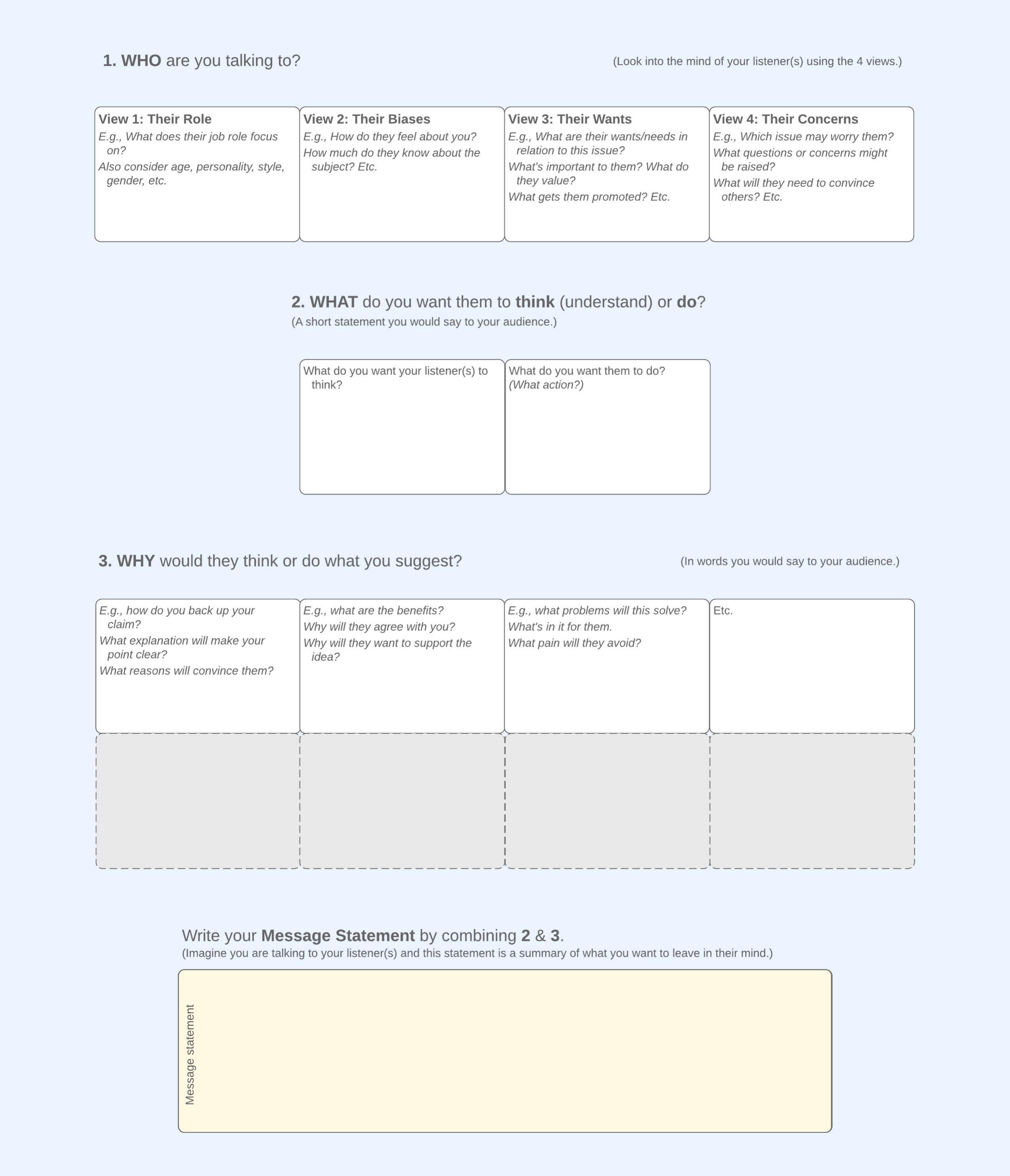
How to write a speech outline and up your presentation game
Reading time: about 8 min
Topics:
One reason people find public speaking daunting is they don’t have a simple method to sort their ideas, which can leave them feeling unprepared for the task ahead. Rather than being excited about what they have put together, they think, “Agh, that’ll have to do. I’m out of time.” This feeling, in turn, can have a negative impact on physical and mental energy levels during your talk. If you don’t feel confident, you won’t sound confident, and you’re not likely to impress your audience. If you go in confidently, the audience will be more willing to accept your ideas.
Whether you’re pitching a business idea or delivering a heartfelt wedding speech, you need to consider the perspective of your audience, identify your key message, and decide on the best way to engage your audience from start to finish.
The Vivid Speech Outline can help you write a compelling speech through a visual process. This methodology was published in Cam Barber’s 2016 book, “What’s Your Message?,” and is used by over 100,000 people. It can save you time and increase your impact.
Let’s take a look at how a speech outline works and how you can use Lucidchart to make your own.
Ready to jump right into a speech outline template?
Register for Lucidchart to get started.
What is a speech outline?
A persuasive speech outline gives you a map of the key ideas of your speech. First, it should ask you to consider your audience’s perspective and the key message you want them to remember from your talk. Then, it should guide you in creating a clear, organized structure for your presentation.
The Vivid Speech Outline in Lucidchart does both. It’s built on neuroscience, which shows that you can avoid anxiety and improve brain performance dramatically when you do the following:
-
Get information out of our heads and create a simple framework on the page: Humans have a strict limit to the amount of information that they can hold and consider in their mind at any one time. An outline lets your brain focus on one step at a time rather than becoming overwhelmed.
-
Prioritize, compare, and think deeply during the outline stage, not when overwhelmed by details: The prefrontal cortex, the clarification part of the brain, requires a lot of energy to function. An outline keeps you focused and avoids you hitting “the wall.”
-
See the relationship between ideas visually: It’s hard to think of new ideas if they don’t connect to existing ideas in some way.
Lucidchart’s Vivid Speech Outline template
Lucidchart has created a template based on Cam’s Vivid Speech Outline to help demystify and speed up the speech writing process.
The Vivid Speech Outline template demonstrates how to write a speech outline through the refinement of two parts: your overall message statement, which is the main point of your presentation, and your chunk structure, which acts as the body and building blocks of your speech. Clarifying your message statement first helps to focus your thinking when you structure your ideas.

Step 1: Message statement
The first page of the speech outline is where you define your transferable message. The message statement page asks three important questions:
- Who are you speaking to? You need to look into the mind of your listeners. What’s their job role, their biases, and their wants and concerns? If you don’t understand your audience’s perspective, you won’t be able to get through to them, no matter how important your ideas may be.
- What do you want them to think or do? Do you want them to think something, e.g., “This project will succeed” or “Learning this method will make you better at your job”? Or do you want them to do something, like sign the contract or try the product?
- Why would they think or do what you suggest? Why should your audience sign the contract, try out the product, or believe that the project will succeed? List the reasons, arguments, examples, evidence, etc. (focused on what you know about your audience).
By combining the answers to questions two and three, you will have a draft of your message statement, which you will then transfer to the second page and use as your speech’s conclusion.
Pro tip: The best way to know if this message statement truly encapsulates your point is to test it. Imagine you are finishing your presentation. Think of your imaginary audience and say your message statement out loud. Does it bring your idea to life? Is this the one key message you want your listeners to recall? If not, repeat the process until your message statement feels complete.

Step 2: Chunk structure
The second page of the template gives you a one-page summary of your entire speech or presentation in brief, narrow pieces called chunks. This allows you to separate the world’s overwhelming details into categories, sections, paragraphs, segments, etc., and think more clearly.
The foundation of your one-page chunk structure is as follows:
1. Presentation title
Create a simple yet captivating title to capture attention and set expectations.
2. Two to four chunks
Make your speech easily digestible by segmenting it into chunks. Depending on what the situation calls for, you can choose two to four chunks or main ideas. You could choose as many segments as you like, but if you include more than four, your talk will start to seem complicated. When announcing the overview of your speech, every audience will be pleased to hear that your talk requires only two, three, or four main ideas to follow.
Inside each main idea or chunk, be sure to include:
-
A chunk heading: This heading simply states the issue to be discussed.
-
Details: List the examples, evidence, stories, charts or whatever details that help bring a key point to life beneath the chunk headings.
-
The key point: People forget most of what they hear, which is why you should state the key point at the end of each chunk. Even if your listeners won’t remember all the details, you hope they will remember the main point for each particular chunk.
For the conclusion, simply transfer over your message statement from the first page. Although you may want to re-test the message statement (from the first page) to see how it flows with the new details you’ve added to your speech outline, you’ve already written your big finish.
Pro tip: Now that you have a completed chunk structure, you can practice your speech from start to finish in less than a minute. Because you have a one-page map of all your important points for this talk in the chunk structure, you can test your message and structure––the yellow shapes (the title, optional introduction, chunk headings, key points, and message statement)––out loud. Most of the time, you won’t need to learn every word of your speech by heart. You just need to make sure you’re clear on the message and structure.
Benefits of the Vivid Speech Outline
The Vivid Speech Outline creates an environment for natural confidence and impact. By creating a persuasive speech outline, you can:
- Save time and effort by identifying your message and key points as the first step in the writing process.
- Be more efficient and minimize the mental load by splitting up the outlining and structuring of your speech.
- Reduce uncertainty and anxiety early in your preparation by considering the tough questions your audience might ask, sticking to the process, and testing the flow your talk.
Use the Vivid Speech Outline to take advantage of these benefits and get a competitive edge.
Using Lucidchart’s Vivid Speech Outline template to create your own presentation
Lucidchart’s template shows you how to write a speech outline that eloquently communicates your innovative message and engages your audience.
Use the Vivid Speech Outline custom shapes to quickly build your message statement and chunk structure pages. Simply drag and drop the custom shapes from the shape repository (or any shape in the toolbox) on the canvas, and fill in the details, chunk headings, or message statement. As you line up your points and supporting details, you’re more likely to notice if some of your ideas don’t quite fit. To make a change, drag and rearrange the shapes any way you want without losing any of the work you’ve already done. As mentioned above, key shapes for the Vivid Speech Outline are also colored to make it easier for you to practice your main ideas.
Lucidchart’s integration with Google Slides makes it easy to export your chunk structure to a slideshow presentation. Preview, edit, and rearrange the already created slides by clicking on the “Slides” icon in the dock to the right of the canvas, and then, with one click, send your finalized chunk structure to Google Slides. You can also select the “Present” option for a quick slide presentation within Lucidchart.
Creating your speech outline in Lucidchart means you also have access to all its sharing and collaboration features. Whether you want to have someone review your speech or you need to work on a presentation as a team, you can email access links to others, invite them to view, comment on, or edit the document, or chat with those with whom you’ve shared the document. Once given access to your document, your whole team can work on it and see each other’s changes in real time.
The beauty of this speech outline is in its simplicity and flexibility. With the help of Lucidchart, you can quickly structure a persuasive speech outline that works for any situation.
Get your free Lucidchart accountAbout Lucidchart
Lucidchart, a cloud-based intelligent diagramming application, is a core component of Lucid Software's Visual Collaboration Suite. This intuitive, cloud-based solution empowers teams to collaborate in real-time to build flowcharts, mockups, UML diagrams, customer journey maps, and more. Lucidchart propels teams forward to build the future faster. Lucid is proud to serve top businesses around the world, including customers such as Google, GE, and NBC Universal, and 99% of the Fortune 500. Lucid partners with industry leaders, including Google, Atlassian, and Microsoft. Since its founding, Lucid has received numerous awards for its products, business, and workplace culture. For more information, visit lucidchart.com.
Related articles
4 Steps to Wrangling the Writing Process
No matter what schedule or settings works best for you, these tried-and-true writing process steps keep any writing project moving
How to Use Graphic Organizers to Write Better Essays
If you’re a student, there’s no way around it: You’re going to have to write essays. But there is an easier way to brainstorm, structure, and write the perfect essay. Learn how graphic organizers can help and get started with templates from Lucidchart.
